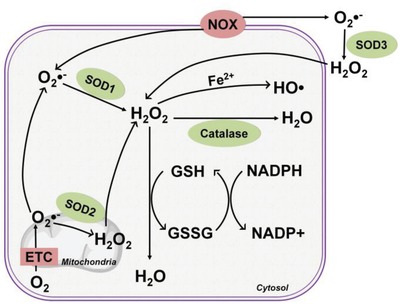Figure 3.

Regulation of redox homeostasis. Primary intracellular production of radical oxygen species (ROS) is derived from the metabolic mitochondrial ETC and membrane‐bound NADPH oxidase (NOX). Enzymes, such as superoxide dimutases (SODs) and catalase, in conjunction with antioxidant molecules, reduced glutathione (GSH), and NADPH, perform critical roles in the endogenous antioxidant defense system to preserve redox homeostasis. Anion superoxide (O2•−) is the leading form of produced ROS, which is rapidly converted into cell permeable hydrogen peroxide (H2O2) by SOD2 in the mitochondria, by SOD1 in the cytosol, and extracellularly by SOD3. H2O2 can be catalyzed to the most reactive hydroxyl radicals (HO•) in the presence of Fe2+ (Fenton reaction) or be converted into water (H2O) by catalase. The reduced form of glutathione (GSH) and the oxidized form of glutathione (GSSG), together with a reducing agent (e.g., NADPH) represent another major antioxidant mechanism converting radical H2O2 to H2O.
